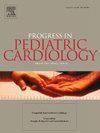Outcomes of balloon angioplasty in infants with simple or complex recurrent coarctation of the aorta
IF 0.8
Q4 PEDIATRICS
引用次数: 0
Abstract
Background
Recurrence of coarctation of the aorta (CoA) is a relatively common complication following surgical correction in neonates. Balloon angioplasty is the favored treatment for recurrent CoA in infancy and early childhood, but persistent or recurrent obstruction remains a challenging complication.
Objectives
This retrospective cohort study aims to assess outcomes of balloon angioplasty for infants with recurrent CoA based on the complexity of cardiac defects at the time of surgical intervention.
Methods
Data were analyzed from patients at a single tertiary care center who underwent balloon angioplasty for recurrent CoA within their first year of life between 2002 and 2021.
Results
A total of 41 patients were included and separated into simple (n = 26) or complex (n = 15) cohorts based on the coexisting cardiac defects present. These cohorts were similar in age, weight, sex, and time since initial surgical repair. The complex cohort had a significantly higher rate of subsequent coarctation re-intervention within a 2-year follow-up period (73 % vs. 31 %, p = 0.003, RR = 2.4; 95 % CI = 1.2–4.6, p = 0.003).
Conclusion
Our findings suggest that recurrent CoA in the presence of additional complex congenital heart disease may not be as amenable to balloon angioplasty in infants and should be considered when counseling patient families.
婴儿单纯性或复合性复发性主动脉缩窄球囊血管成形术的疗效
背景:主动脉缩窄(CoA)复发是新生儿手术矫治后较为常见的并发症。球囊血管成形术是治疗婴儿期和幼儿期复发性CoA的首选方法,但持续性或复发性梗阻仍然是一个具有挑战性的并发症。目的:本回顾性队列研究旨在评估基于手术干预时心脏缺陷复杂性的球囊血管成形术治疗复发性CoA婴儿的结果。方法对2002年至2021年间在单一三级护理中心接受球囊血管成形术治疗复发性CoA的患者进行数据分析。结果共纳入41例患者,根据合并心脏缺陷情况分为单纯组(n = 26)和复杂组(n = 15)。这些队列在年龄、体重、性别和首次手术修复后的时间上相似。复杂队列在2年随访期间的缩窄再干预率显著较高(73% vs. 31%, p = 0.003, RR = 2.4;95% CI = 1.2 ~ 4.6, p = 0.003)。结论:我们的研究结果表明,在伴有其他复杂先天性心脏病的婴儿中,复发性CoA可能不适合球囊血管成形术,在咨询患者家属时应予以考虑。
本文章由计算机程序翻译,如有差异,请以英文原文为准。
求助全文
约1分钟内获得全文
求助全文
来源期刊

PROGRESS IN PEDIATRIC CARDIOLOGY
PEDIATRICS-
CiteScore
0.90
自引率
11.10%
发文量
69
审稿时长
75 days
期刊介绍:
Progress in Pediatric Cardiology is an international journal of review presenting information and experienced opinion of importance in the understanding and management of cardiovascular diseases in children. Each issue is prepared by one or more Guest Editors and reviews a single subject, allowing for comprehensive presentations of complex, multifaceted or rapidly changing topics of clinical and investigative interest.
 求助内容:
求助内容: 应助结果提醒方式:
应助结果提醒方式:


